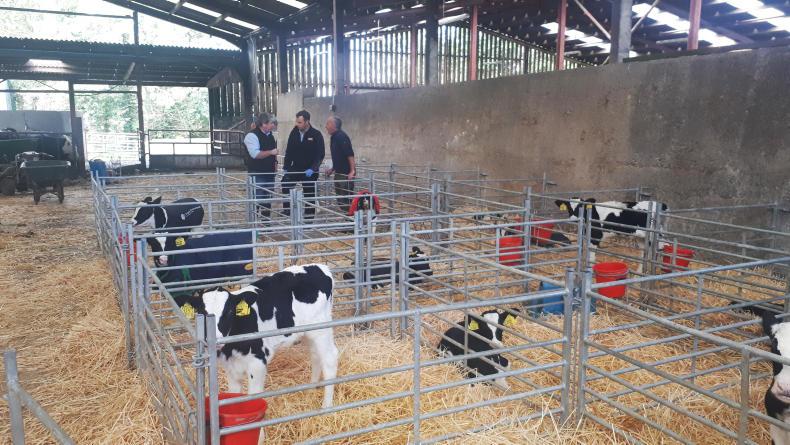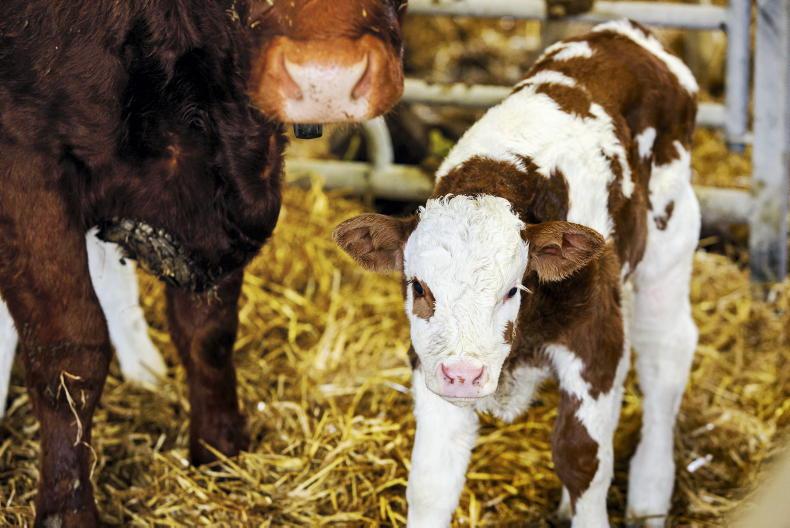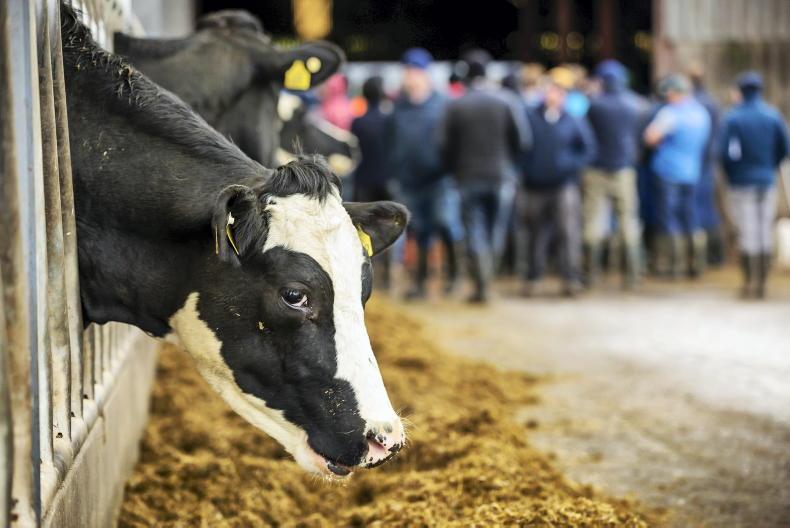It’s getting close to the right time for completing any last field jobs now. While ground conditions are still good in most parts (including Tyrone) now is the time to get any fertiliser like potash spread.
Late last week I was on two farms in Tyrone where both farmers were spreading 0:0:60 on paddocks that were index 1 and 2 for potassium (K). With more rain on the way and shorter days, ground conditions could get tricky very quickly.
A number of the autumn calving farms I visited last week were suggesting they would like to have more cows either calved or in the pipeline for calving in the next month. Some farmers now realise they won’t have 60% of the herd calved before Christmas.
Up north, calving in November and December effectively means you take on a lot of the costs of producing winter milk and forgo a lot of the milk price bonus available. Producing winter milk increases feed costs – as a business you need all the bonuses available. Your maiden heifers are one of the best tools available to improve calving pattern. Try to get them calving early, as inevitably they will slip slightly from year to year. At the very least, assess where you are on calving rate and develop a plan of action if you need to improve it.
For some farms up north, it’s getting close to the end for grazing freshly calved autumn cows. Remember, often intakes are low post-calving, but very quickly intakes and milk production rise.
If you have genetics that are bred for producing milk volume, very easily a significant gap can open up between actual intakes and requirements. Grazing low covers a long way from the parlour is not ideal for freshly-calved high-volume cows. A better option is to split the herd and manage closer for feed requirements. Every herd has enough dry cows, young stock or spring-calvers to tidy up what grass is left.
Weekly roundup
Get fieldwork completed and fix any lime or potash issues now before next spring.As numbers in calf houses increase try to get the older calves into batches rather than individual pens.Ensure calves are getting milk equivalent to 10% of liveweight. Four litres per day is not enough for 60kg calves – most calves I saw last week were 45kg to 50kg at birth. Umbilical system is a great way to get slurry out without wrecking farm roads.Farmer focus: Stephen Wallace, Seaforde, Co Down
It’s all go on the Wallace farm near Seaforde, Co Down, at the moment. When we called to see Stephen late last week, there was a hum from the John Deere on the slurry pump, newborn calves bawled and bounced around in fresh straw, and the waste water drained out of the parlour as the wash routine came to an end.
Stephen had just finished drying off 10 cows that are due to calve in about eight weeks’ time.
Already, Stephen has 40 or so other cows dried off that were set to calve within the next eight weeks.
On Thursday last, there were 120 milking, which were a combination of 90 stale cows and 30 fresh calvers.
The plan is to have 70 to 80 freshly calved cows on the farm by early December.
Compact calving
The calving period starts in early September and runs through into April. Stephen wants to make this more compact.
He does not like the idea of having a calving jack in one hand and an AI straw in another – he wants a more defined calving period and preferably one period rather than split calving.
All milkers are still in the one group at grass, with concentrate fed to yield in the milking parlour.
The feeder wagon was not in use after a busy summer when the farm dried up, so buffer feeding was necessary. Stephen had plans to separate the fresh calvers this week and, depending on weather and grazing conditions, house them full-time and build them up on an indoor diet.
Feeding
Feeding at the moment is about 5.5kg of meal and grazed grass, with milk yield at 23 litres per cow/day.
Stephen said: “The plan is to bring in fresh calvers full-time over the next week. We have some freshly calved cows that would have the potential to milk upwards of 50 litres per day.
“We find if they are not well looked after in the first number of weeks, they can get problems,” he said.
Down through the years, Stephen’s calving has spread out over a number of months into a year-round calving pattern.
One of the objectives for Stephen in getting involved with Dairylink is to try to bring this into a more compact calving pattern to help streamline the workflow.
Housing
Calves are fed on four litres of pasteurised milk per day. They are housed in a large open shed near the cow cubicles in small individual pens, using sheep hurdles to create the pens.
Each pen has a bucket with water and meal on offer and just recently Stephen started using coats on the calves.
The intention with this relatively new setup was to take calves out of smaller sheds into a larger shed with more air space.
Yes, they are sharing air space with cows when they are inside, but there is good airflow in and out of the shed.
On this farm, the calves stay in these individual pens for up to six weeks.
Individual attention is time-consuming and hard work, but Stephen is open to looking at group penning at a younger age by adapting some existing older sheds.
It’s getting close to the right time for completing any last field jobs now. While ground conditions are still good in most parts (including Tyrone) now is the time to get any fertiliser like potash spread.
Late last week I was on two farms in Tyrone where both farmers were spreading 0:0:60 on paddocks that were index 1 and 2 for potassium (K). With more rain on the way and shorter days, ground conditions could get tricky very quickly.
A number of the autumn calving farms I visited last week were suggesting they would like to have more cows either calved or in the pipeline for calving in the next month. Some farmers now realise they won’t have 60% of the herd calved before Christmas.
Up north, calving in November and December effectively means you take on a lot of the costs of producing winter milk and forgo a lot of the milk price bonus available. Producing winter milk increases feed costs – as a business you need all the bonuses available. Your maiden heifers are one of the best tools available to improve calving pattern. Try to get them calving early, as inevitably they will slip slightly from year to year. At the very least, assess where you are on calving rate and develop a plan of action if you need to improve it.
For some farms up north, it’s getting close to the end for grazing freshly calved autumn cows. Remember, often intakes are low post-calving, but very quickly intakes and milk production rise.
If you have genetics that are bred for producing milk volume, very easily a significant gap can open up between actual intakes and requirements. Grazing low covers a long way from the parlour is not ideal for freshly-calved high-volume cows. A better option is to split the herd and manage closer for feed requirements. Every herd has enough dry cows, young stock or spring-calvers to tidy up what grass is left.
Weekly roundup
Get fieldwork completed and fix any lime or potash issues now before next spring.As numbers in calf houses increase try to get the older calves into batches rather than individual pens.Ensure calves are getting milk equivalent to 10% of liveweight. Four litres per day is not enough for 60kg calves – most calves I saw last week were 45kg to 50kg at birth. Umbilical system is a great way to get slurry out without wrecking farm roads.Farmer focus: Stephen Wallace, Seaforde, Co Down
It’s all go on the Wallace farm near Seaforde, Co Down, at the moment. When we called to see Stephen late last week, there was a hum from the John Deere on the slurry pump, newborn calves bawled and bounced around in fresh straw, and the waste water drained out of the parlour as the wash routine came to an end.
Stephen had just finished drying off 10 cows that are due to calve in about eight weeks’ time.
Already, Stephen has 40 or so other cows dried off that were set to calve within the next eight weeks.
On Thursday last, there were 120 milking, which were a combination of 90 stale cows and 30 fresh calvers.
The plan is to have 70 to 80 freshly calved cows on the farm by early December.
Compact calving
The calving period starts in early September and runs through into April. Stephen wants to make this more compact.
He does not like the idea of having a calving jack in one hand and an AI straw in another – he wants a more defined calving period and preferably one period rather than split calving.
All milkers are still in the one group at grass, with concentrate fed to yield in the milking parlour.
The feeder wagon was not in use after a busy summer when the farm dried up, so buffer feeding was necessary. Stephen had plans to separate the fresh calvers this week and, depending on weather and grazing conditions, house them full-time and build them up on an indoor diet.
Feeding
Feeding at the moment is about 5.5kg of meal and grazed grass, with milk yield at 23 litres per cow/day.
Stephen said: “The plan is to bring in fresh calvers full-time over the next week. We have some freshly calved cows that would have the potential to milk upwards of 50 litres per day.
“We find if they are not well looked after in the first number of weeks, they can get problems,” he said.
Down through the years, Stephen’s calving has spread out over a number of months into a year-round calving pattern.
One of the objectives for Stephen in getting involved with Dairylink is to try to bring this into a more compact calving pattern to help streamline the workflow.
Housing
Calves are fed on four litres of pasteurised milk per day. They are housed in a large open shed near the cow cubicles in small individual pens, using sheep hurdles to create the pens.
Each pen has a bucket with water and meal on offer and just recently Stephen started using coats on the calves.
The intention with this relatively new setup was to take calves out of smaller sheds into a larger shed with more air space.
Yes, they are sharing air space with cows when they are inside, but there is good airflow in and out of the shed.
On this farm, the calves stay in these individual pens for up to six weeks.
Individual attention is time-consuming and hard work, but Stephen is open to looking at group penning at a younger age by adapting some existing older sheds.









SHARING OPTIONS